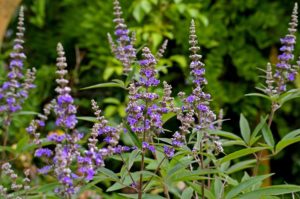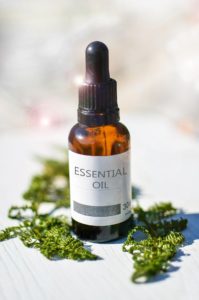Does Monk’s Pepper Help with Endometriosis?
 Monk’s pepper (Vitex agnus-castus) has a well-established reputation as a traditional medicinal plant, particularly for addressing women’s health concerns. Its effectiveness in managing premenstrual syndrome, infertility, and irregular menstrual cycles has been substantiated [6]. However, the question remains: can monk’s pepper also provide relief for those with endometriosis?
Monk’s pepper (Vitex agnus-castus) has a well-established reputation as a traditional medicinal plant, particularly for addressing women’s health concerns. Its effectiveness in managing premenstrual syndrome, infertility, and irregular menstrual cycles has been substantiated [6]. However, the question remains: can monk’s pepper also provide relief for those with endometriosis?
Colloquially referred to as the “chaste tree,” this plant—despite its misleading name, as it is actually a large shrub—has historical naturopathic applications. It was cultivated in monastery gardens for centuries due to its unique ability to suppress libido, particularly in men, thanks to the mildly pungent-tasting seeds. This quality made it a convenient ingredient for culinary use, offering a beneficial side effect for monks. But how can monk’s pepper be harnessed for the well-being of women?
How Does Monk’s Pepper Work?

Monk’s pepper is known for its effectiveness in alleviating premenstrual syndrome symptoms, including breast pain.
The precise mechanism by which monk’s pepper regulates the hormone system via the pituitary gland has not been definitively established. It is suspected that its effects may involve interactions with dopamine, opioid, or estrogen-like components [8]. Nonetheless, it is confirmed that active compounds from the fruit of this shrub influence human hormonal balance, regardless of gender [7].
One well-documented effect of monk’s pepper is the ability to inhibit the release of prolactin [1]. This hormone plays a role in mammary gland function, including milk production during lactation. As a result, monk’s pepper is successfully used to alleviate breast pain (mastodynia), a premenstrual syndrome (PMS) symptom. Additionally, it can help mitigate other PMS symptoms, such as water retention.
Monk’s pepper also supports the production of the corpus luteum hormone (progestins). This makes it valuable in positively influencing hormones, particularly in fertility concerns due to low progestin levels or issues with the corpus luteum.
For women with irregular menstrual cycles, monk’s pepper preparations can aid in their regulation. Thus, monk’s pepper is utilized to gently regulate the female hormonal balance that may be slightly imbalanced [2]. Regardless of the purpose and dosage of monk’s pepper-based preparations, it is essential to note that their hormone-regulating effects do not manifest immediately. To assess their effectiveness, it is recommended to use them for at least three monthly cycles [5].
Side Effects of Monk’s Pepper.
Side effects from monk’s pepper are infrequent and can vary from mild itching and headaches to gastrointestinal issues and dizziness. Allergic reactions are a possibility and may present as symptoms such as shortness of breath, facial swelling, and difficulty swallowing. In such reactions, it is imperative to consult a doctor without delay.
Can Monk’s Pepper Benefit Endometriosis?

Monk’s pepper’s essential oil possesses analgesic and anti-inflammatory properties.
While there have been limited scientific studies on this subject, there is some promising scientific evidence and anecdotal reports.
In endometriosis management, the goal is often to reduce estrogen levels and increase progestin levels.
Although monk’s pepper contains estrogen-like components, most studies have indicated that it either has no effect on estrogen levels or may even inhibit them. This suggests that monk’s pepper could potentially slow the growth of endometriosis lesions [3].
However, one study observed that the active ingredients in monk’s pepper act in a way similar to estrogens, which could potentially promote the growth of endometriosis lesions. Some studies related to other gynecological conditions have also shown increased progestin concentrations. Overall, the scientific evidence regarding the use of monk’s pepper in endometriosis is not entirely consistent.
Furthermore, a study involving mice [4] investigating the effects of the essential oil from monk’s pepper fruit found anti-inflammatory and analgesic effects, with the analgesic effect observed within 15 minutes. However, whether these findings can be directly applied to humans still requires further research.
Given the current state of the research, there is no definitive recommendation for using monk’s pepper in endometriosis. However, depending on the individual’s specific circumstances and treatment plan, it may be worthwhile to consider a three-month trial under the guidance of a healthcare professional.
When Should Monk’s Pepper Be Avoided?

Women taking hormone preparations are advised to steer clear of monk’s pepper.
Women taking hormone preparations, antidepressants, or other medications should exercise caution when considering monk’s pepper-based supplements. Having a detailed discussion about this with a healthcare provider is crucial. Monk’s pepper is not recommended for individuals with a history of breast cancer, during pregnancy, or while lactating, as the hormone-regulating effects of this medicinal plant can potentially lead to complications.
In Summary:
Scientific studies have examined the efficacy of monk’s pepper in alleviating premenstrual syndrome (PMS) symptoms, showing an effect typically occurring after an average of three monthly cycles. While research on using monk’s pepper in endometriosis is still inconclusive, preliminary indications suggest that it may possess anti-inflammatory and pain-reducing properties in endometriosis, influence hormone balance positively, and potentially inhibit the growth of endometriosis lesions.
It is essential to recognize that while monk’s pepper is derived from a plant, its effects can be drug-like. Therefore, it should not be used without proper medical advice and guidance.
References
- Finding the Perfect Nutritionist: A Step-by-Step Guide - 5. October 2023
- Does Monk’s Pepper Help with Endometriosis? - 5. October 2023
- A Brief Overview of Dietary Fats - 29. September 2023
